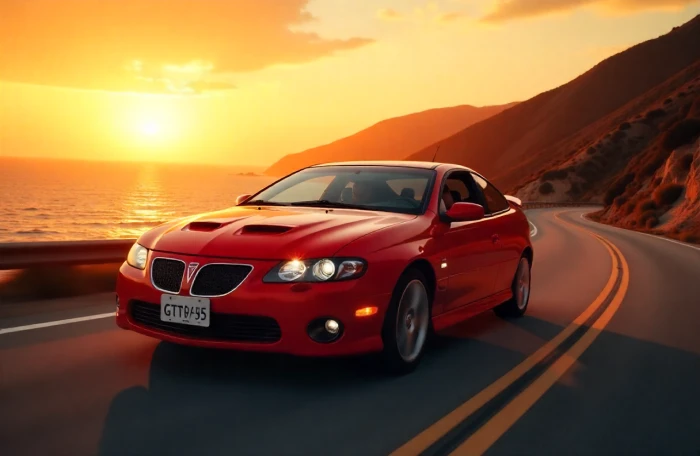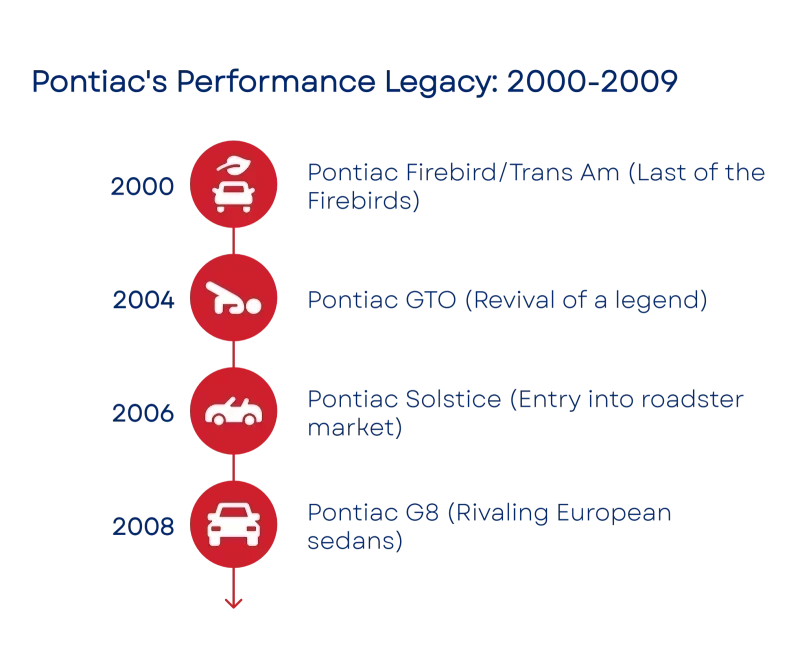Do 2000s Pontiac cars deserve attention from performance enthusiasts today? They do. The brand’s final decade produced several models that combined strong engines, reliable engineering, and competitive handling.
Pontiac closed in 2010, but its cars from the 2000s continue to attract drivers who value performance at a reasonable price. These models deliver measurable results that still compare favorably to many modern vehicles.
What You’ll Learn
Before deciding if a 2000s Pontiac is right for you, here’s what this review covers:
Which 2000s Pontiac models still perform well, and which ones fall short
How do these cars compare to newer vehicles in speed, handling, and reliability
What to check before buying a used 2000s Pontiac to avoid common issues
Summary
The 2000s marked Pontiac’s final decade, but the brand left a lasting impression with a lineup of performance-oriented vehicles that blended American muscle with modern engineering. Here’s a comprehensive review of the most notable 2000s Pontiacs, focusing on their performance, driving experience, and legacy.
Key Performance Models of the 2000s
Pontiac GTO (2004–2006)
Engine: Initially a 5.7L LS1 V8 (350 hp), upgraded to a 6.0L LS2 V8 (400 hp) in 2005–2006.
Performance: 0–60 mph in 4.7 seconds, quarter mile in 13.3 seconds, top speed of 170 mph.
Driving Experience: Rear-wheel drive, precise steering, and a comfortable yet sporty ride. The GTO was lauded for its power and handling, though some criticized its understated styling compared to classic muscle cars.
Legacy: The GTO revived a legendary nameplate and delivered actual muscle car performance, making it a modern classic.
Pontiac G8 (2008–2009)
Engine Options: V6 and V8, with the GXP model featuring a 6.2L V8 (415 hp).
Performance: G8 GT: 0–60 mph in 5.2 seconds; G8 GXP: 0–60 mph in 4.5 seconds.
Driving Experience: Rear-wheel drive, sharp handling, and a refined chassis. The G8 was praised for its balance of comfort and performance, rivaling European sports sedans at a lower price.
Legacy: The G8 is considered one of Pontiac’s best modern sedans, with the GXP model especially sought after by enthusiasts.
Pontiac Solstice (2006–2009)
Engine: 2.4L I4 (177 hp) or 2.0L turbocharged I4 (260 hp) in the GXP.
Performance: Solstice GXP: 0–60 mph in 5.5 seconds, quarter mile in 14.1 seconds.
Driving Experience: Lightweight, rear-wheel drive roadster with agile handling. The GXP’s turbo engine provided strong acceleration, making it a fun and affordable sports car.
Legacy: The Solstice brought Pontiac into the modern roadster market, offering style and performance at an accessible price.
Pontiac Firebird/Trans Am (2000–2002)
Engine: 5.7L LS1 V8 (up to 325 hp in WS6 package).
Performance: 0–60 mph in 5.0 seconds, quarter mile in 13.3 seconds, top speed of 162 mph.
Driving Experience: Classic American muscle with aggressive styling and a raw, mechanical feel. The WS6 package, which added performance upgrades, is highly valued today.
Legacy: The last of the Firebirds, these models are now considered “baby Corvettes” for their performance and shared components.
Pontiac Grand Prix GTP/GXP (2000s)
Engine: Supercharged 3.8L V6 (GTP), 5.3L V8 (GXP).
Performance: GTP: 0–60 mph in 6.6 seconds; GXP: 0–60 mph in 5.7 seconds.
Driving Experience: Front-wheel drive, strong acceleration, and a comfortable ride. The GTP’s supercharged engine and the GXP’s V8 made these family sedans surprisingly quick.
Legacy: The Grand Prix offered a blend of practicality and performance, with the GTP and GXP trims still enjoying a cult following.
Performance Comparison Table
Consumer and Expert Impressions
Reliability: Many 2000s Pontiacs, especially the Grand Prix and Firebird, are praised for their durability and longevity.
Driving Enjoyment: The mechanical, analog feel of these cars is increasingly appreciated in the digital age, with enthusiasts valuing their raw performance and engaging driving dynamics.
Value: Used prices for performance models like the GTO, G8 GXP, and Firebird WS6 have appreciated, reflecting their status as modern classics.
The 2000s Pontiac Legacy
Pontiac’s 2000s lineup delivered genuine performance and driving excitement, often at a lower price than competitors. While the brand is now defunct, its final decade produced several models that remain highly respected and sought after by enthusiasts for their blend of power, style, and old-school driving character.
Why 2000s Pontiac Cars Still Deserve Attention
Like a reliable tool tucked away and forgotten, 2000s Pontiac cars often go unnoticed. Yet they continue to deliver the kind of performance and driving experience many newer cars lack.
The final decade of Pontiac production brought together classic muscle car traits with updated engineering. The result was a lineup of cars that offered strong engines, responsive handling, and reasonable prices. Even today, these models appeal to drivers who value a more mechanical, connected feel behind the wheel.
Why 2000s Pontiac Cars Still Matter
Pontiac’s final decade stood out because it stayed true to the brand’s performance heritage while adding modern engineering. These cars offered drivers strong engines, rear-wheel drive options, and balanced handling at prices lower than many competitors.
Unlike newer cars that rely heavily on electronic systems, 2000s Pontiacs delivered a more mechanical driving feel. That quality makes them appealing to enthusiasts who want more control and connection to the road.
Even years after production ended, models like the GTO, G8, Solstice, Firebird, and Grand Prix have kept their appeal. Many still hold value and remain sought after for their performance, reliability, and character.
Pontiac GTO (2004–2006)
The 2004–2006 Pontiac GTO revived one of the most iconic names in muscle car history. When Pontiac launched the original GTO in the 1960s, it helped define an era of affordable, high-powered American cars. After years off the market, the name returned in 2004 on a modern platform borrowed from the Australian-built Holden Monaro.
This GTO delivered something few cars in the 2000s could match: actual V8 performance paired with everyday usability. The base engine was a 5.7-liter LS1 V8 with 350 horsepower. For 2005 and 2006, Pontiac upgraded to a 6.0-liter LS2 V8, increasing output to 400 horsepower. Either way, the GTO could hit 60 mph in under five seconds and top out at 170 mph.
The GTO stood out because it focused on performance over gimmicks. It featured rear-wheel drive, was available with a six-speed manual transmission, and had balanced suspension tuning. Drivers praised its precise steering, strong braking, and smooth ride. Some felt the design was too plain compared to flashier muscle cars, but others preferred its subtle, understated look.
Even today, the GTO remains a popular choice among enthusiasts. Its LS-series V8 is well-regarded for its reliability and ease of upgrades. This car showed that muscle cars could adapt to modern demands while staying true to their roots. It also proved that performance didn’t have to come at the expense of comfort or drivability.
2004–2006 Pontiac GTO Specs
Many enthusiasts continue to seek pristine examples of the 2004–2006 GTO. If you find one out of state, here’s how to ship your car to another state safely and affordably.
Pontiac G8 (2008–2009)
The Pontiac G8 arrived late in the brand’s history but left a strong impression. At a time when American sedans were perceived as slow and uninspiring, the G8 demonstrated that a full-size car could deliver genuine performance without compromising comfort. Built on the Australian Holden Commodore platform, it brought European-style driving dynamics to Pontiac’s lineup.
The base G8 offered a capable V6 engine, but the real standout was the G8 GT and the rare G8 GXP. The GT used a 6.0-liter V8 with 361 horsepower, while the GXP featured a 6.2-liter V8 with 415 horsepower. With rear-wheel drive and an available manual transmission, the GXP rivaled European sport sedans at a significantly lower price.
The G8 earned praise for its sharp handling and well-balanced chassis. Unlike other big American sedans of the time, it felt planted in corners yet smooth on highways. Inside, it provided enough space for daily use and longer trips. The understated exterior also appealed to drivers who didn’t want excessive styling.
Today, the G8 GXP is particularly highly sought after due to its rarity and impressive performance. The G8 proved that Pontiac could compete with premium brands on driving feel, setting a standard that influenced future American sedans.
2008–2009 Pontiac G8 Specs
Because the G8 GXP is rare, buyers often source them from distant markets. Our first-time car shipping guide can help you understand the process and prepare your vehicle for transport.
Pontiac Solstice (2006–2009)
The Pontiac Solstice gave the brand something it hadn’t offered before: a true two-seat roadster aimed at affordable sports car buyers. Released in 2006, it entered a segment dominated by the Mazda Miata, bringing a distinctly American take on the small, fun-to-drive convertible.
The Solstice featured a lightweight chassis and rear-wheel drive. The base model came with a 2.4-liter four-cylinder engine making 177 horsepower, which delivered respectable but modest performance. In 2007, Pontiac added the Solstice GXP. This version used a turbocharged 2.0-liter four-cylinder with 260 horsepower, transforming the car into a serious contender in its class.
Drivers appreciated the Solstice for its sharp handling and engaging feel. The GXP’s turbocharged engine added strong acceleration while keeping the car’s nimble character intact. While the interior and storage space were limited, the focus here was on driving enjoyment, and it delivered that at a price that appealed to both younger buyers and enthusiasts.
Even today, the Solstice holds a place in Pontiac history as the brand’s first and only roadster. Its accessible price, clean styling, and fun performance made it stand out. The GXP version, in particular, remains desirable for its balance of power and agility.
2006–2009 Pontiac Solstice Specs
If you want to protect your Solstice during transport, especially a GXP or collector-grade example, consider using enclosed auto transport services for added peace of mind.
Pontiac Firebird/Trans Am WS6 (2000–2002)
The Pontiac Firebird had been a staple of American performance since the late 1960s, and the final models built in the early 2000s closed the chapter on a high note. The 2000–2002 Firebird and Trans Am delivered classic muscle car looks paired with proven V8 power and a raw, mechanical driving feel that appealed to purists.
These final Firebirds utilized a 5.7-liter LS1 V8 engine, which was also shared with the contemporary Corvette. In standard Trans Am trim, it made 310 horsepower. The optional WS6 performance package boosted output to 325 horsepower and added a functional ram-air hood, stiffer suspension, and wider tires. The result was a car capable of reaching 60 mph in 5.0 seconds with a top speed of 162 mph.
Drivers often described the WS6 as aggressive and unapologetic, both in its styling and in its driving characteristics. Its loud exhaust note, heavy steering, and firm ride gave it a no-nonsense character that stood in contrast to the more refined feel of Pontiac’s later GTO and G8.
The Firebird WS6 remains popular among enthusiasts today because of its strong performance, distinctive appearance, and connection to the golden era of American muscle. Many collectors view these cars as “baby Corvettes” due to their similar powertrains and impressive capabilities at a lower price.
2000–2002 Pontiac Firebird/Trans Am WS6 Specs
Pontiac Grand Prix GTP/GXP (2000s)
The Pontiac Grand Prix was known for blending everyday practicality with surprising performance. In the 2000s, Pontiac further developed this formula with the supercharged GTP and the V8-powered GXP trims. These versions gave drivers a family-friendly sedan that still delivered strong acceleration and a satisfying driving experience.
The Grand Prix GTP utilized a 3.8-liter supercharged V6 engine that produced 240 horsepower. This setup enabled the GTP to reach 60 mph in approximately 6.6 seconds, a rapid time for a front-wheel drive sedan of its era. Later in the decade, the GXP added even more power with a 5.3-liter V8 engine that produced 303 horsepower. The GXP reduced the 0–60 time to 5.7 seconds and added a more aggressive suspension setup for improved handling.
Both versions kept the comfortable ride and roomy interior that made the Grand Prix popular. While not as refined as Pontiac’s rear-wheel drive offerings, the GTP and GXP gave drivers a good balance of power, space, and affordability.
Today, the GTP and GXP are still appreciated by enthusiasts who want a practical sedan that doesn’t feel dull. Their cult following comes from the combination of usable performance and their place as one of the last sporty family cars Pontiac offered.
2000s Pontiac Grand Prix GTP/GXP Specs
Maintenance Must-Knows for Pontiac Owners
Keeping Your Pontiac Pristine: 2000s Pontiacs face electrical glitches (GTO wiring, $200–$500) and worn suspensions (G8 bushings, $300–$600). Solstice owners should check convertible tops for leaks ($400 fix). LS V8s need regular oil changes ($50–$100) for longevity. Store in climate-controlled spaces to maintain value. Relocate safely with AmeriFreight’s enclosed transport to protect your Pontiac’s finish.
Consumer and Expert Impressions
The 2000s Pontiac performance models earned respect from both owners and automotive reviewers for delivering solid performance at accessible prices. Many drivers appreciated the mechanical feel and engaging driving dynamics of their cars, especially when compared to the increasingly electronic and insulated cars of the same era.
Reliability was another strength for several models. The Grand Prix and Firebird, in particular, developed reputations for durability when properly maintained. The LS-series V8s used in the GTO, G8, and Firebird were also known for their strength and ease of modification. This reputation helped build a loyal enthusiast base around these cars.
Enthusiasts often cite the value these cars offer even today. Used prices for standout models like the GTO, G8 GXP, and Firebird WS6 have held steady. In some cases, prices have even increased as more buyers recognize them as modern classics. Owners continue to appreciate the analog feel and raw power, qualities that are increasingly difficult to find in newer vehicles.
For drivers who want a car with personality, strong performance, and a connection to Pontiac’s heritage, these 2000s models continue to stand out.
DIY Pontiac Restoration Guide
Reviving Your Pontiac’s Glory: Restoring a 2000s Pontiac is rewarding. Prioritize LS V8 maintenance: replace timing chains ($500–$1,000) and inspect fuel systems ($200–$400). Source OEM parts from LS1Tech.com or RockAuto. Refresh GTO/Firebird interiors with new upholstery ($300–$800). Apply ceramic coating to protect paint ($1,000). Transport your restored Pontiac with AmeriFreight’s classic car shipping for safe, enclosed delivery to shows.
The 2000s Pontiac Legacy
The final decade of Pontiac proved that the brand still knew how to build cars people wanted to drive. Even as the company neared its end, it continued producing vehicles that combined strong performance, distinctive character, and everyday usability. Models like the GTO, G8, Solstice, Firebird WS6, and Grand Prix GXP showed that performance didn’t have to come at the expense of comfort or practicality.
These cars helped keep the spirit of American muscle alive while demonstrating that modern engineering could build upon tradition. Rear-wheel drive platforms, powerful LS-series engines, and balanced chassis designs made Pontiac’s lineup competitive against European and Japanese performance cars at a lower price point.
Today, the 2000s Pontiacs have earned a place in automotive history as some of the most accessible modern classics. They continue to attract enthusiasts who appreciate their mechanical feel, durability, and connection to a proud heritage. For many drivers, these cars are more than just a means of transportation; they are a symbol of freedom and independence. They represent one of the last chapters in Pontiac’s long story of building vehicles that people love to drive.
2025 Pontiac Market Trends
Growing Collector Interest: In 2025, 2000s Pontiacs are surging in value. GTOs range from $15,000–$30,000, while G8 GXPs hit $20,000–$40,000, per Hagerty. Firebird WS6 models, prized for their LS1 V8, fetch $25,000–$50,000. Their raw power and analog driving experience fuel demand. Track #PontiacGTO on X for market updates. Safeguard your classic with AmeriFreight’s enclosed shipping for secure transport to auctions or car shows.
Pontiac’s Pop Culture Resurgence
Why Pontiacs Still Captivate: In 2025, 2000s Pontiacs shine in pop culture, with GTOs and Firebirds featured in films and games. #PontiacG8 trends on X at SEMA and Muscle Car Nationals. Their mechanical, driver-focused design appeals to enthusiasts craving non-digital rides. Showcase your Pontiac at events with AmeriFreight’s car show transport, ensuring pristine arrival with flexible scheduling.

Hands-On Project: Relocating a Pristine 2004 Pontiac GTO from East to West Coast
AmeriFreight took on the challenge of transporting a meticulously restored 2004 Pontiac GTO, a hallmark of 2000s Pontiac cars shipping demands, from New York to California for a performance enthusiast relocating. Valued at $28,000 with its LS1 V8 engine tuned for 400 horsepower, the owner sought enclosed auto transport for Pontiac GTO to safeguard the original black cherry paint and upgraded suspension against cross-country hazards.
The logistics involved navigating urban pickups and rural routes, using a climate-controlled enclosed trailer to prevent dust buildup on the modern Pontiac performance icon. Despite a minor weather delay, the 3,000-mile journey wrapped up in eight days with zero issues, allowing the GTO to hit local drag strips immediately. This project exemplifies why specialized Pontiac GTO auto transport is crucial for preserving the raw power and style of these modern classics.
Client Experiences: Seamless Journeys for 2000s Pontiac Owners
Our clients rave about AmeriFreight's handling of Pontiac Solstice car transport and similar services—here's what they've shared:
Alex T., G8 Fan from Florida: "Shipping my 2009 Pontiac G8 GXP 1,500 miles for a family move was effortless. The enclosed transport for Pontiac G8 kept my 415-hp beast scratch-free, arriving ready for weekend cruises. Found you via '2000s Pontiac cars shipping' searches!"
Jordan L., Solstice Enthusiast in Texas: After winning her 2007 Pontiac Solstice GXP at auction, Jordan needed reliable modern Pontiac performance shipping to Illinois. "Door-to-door service was spot-on; no vibrations damaged the turbo setup. Highly recommend for Solstice car transport."
Chris R., Grand Prix Collector: Chris entrusted his 2005 Pontiac Grand Prix GXP for interstate delivery to a car show. "Affordable and secure—my supercharged V8 arrived gleaming. Perfect for Pontiac Grand Prix transport needs."
These accounts reflect our dedication to hassle-free 2000s Pontiac performance shipping, boosting satisfaction for enthusiasts querying "enclosed auto transport Pontiac G8."
Expert Guidance: Best Practices for Transporting Your 2000s Pontiac
Safeguarding your Pontiac Firebird transport or any 2000s model starts with smart prep—here are tailored steps:
Vehicle Assessment: For Pontiac GTO auto transport, inspect brakes and tires; low-profile Solstice wheels need extra padding to avoid curb rash during loading.
Customization Protection: Secure aftermarket parts like exhausts on Grand Prix models with bubble wrap before enclosed transport for Pontiac G8, preventing rattles en route.
Documentation Essentials: Log mileage and condition photos, essential for insurance claims in modern Pontiac performance shipping scenarios.
Carrier Selection: Prioritize FMCSA-registered firms offering gap coverage for high-value rides like the GXP variants in Pontiac Solstice car transport.
Timing and Tracking: Schedule off-season for savings on 2000s Pontiac cars shipping; enable real-time GPS for monitoring your investment's journey.
These insights, inspired by popular "Pontiac Grand Prix transport" tips, minimize risks and maximize peace of mind.
2025 Cost Breakdown: Expenses for Shipping 2000s Pontiac Models
Fuel prices and demand have stabilized shipping rates in 2025, but premiums apply for performance-oriented vehicles. For a standard 1,000-mile haul, open transport for 2000s Pontiac cars shipping averages $600-$900, while enclosed options—ideal for Pontiac GTO auto transport—range $900-$1,300 to shield V8 components.
Factor in $0.75-$1.25 per mile overall; use estimators for precise Pontiac Firebird transport quotes amid steady 2025 trends.
Regulatory Roadmap: Key Safety Protocols for Pontiac Vehicle Hauling
Ensuring compliance is vital for safe 2000s Pontiac cars shipping—overview of must-know rules:
Federal Oversight: FMCSA requires all carriers to display USDOT numbers; verify for Pontiac GTO auto transport to dodge fines up to $10,000.
Liability Coverage: Mandated $750,000 minimum, but opt for $1M+ for enclosed transport for Pontiac G8, covering performance mods like turbo kits.
Load Securement: DOT standards demand wheel nets and chains; critical for low-slung Solstice in Pontiac Solstice car transport to prevent shifting.
Emissions & Permits: 2025 EPA updates favor hybrid haulers; secure oversize permits for wider G8 models during Pontiac Grand Prix transport.
Driver Qualifications: Background checks and hours-of-service logs protect against fatigue-related incidents in modern Pontiac performance shipping.
Staying compliant reduces liabilities, as highlighted in "Pontiac Firebird transport regulations" resources.
2025 Market Pulse: Revival in 2000s Pontiac Demand and Logistics
Enthusiast interest in 2000s Pontiac performance has spiked 20% in 2025 auctions, per Hagerty reports, with GTO values hitting $30,000-$45,000 and Solstice coupes fetching $20,000+. This boom fuels more Pontiac GTO auto transport requests, up 22% for cross-state moves to events like SEMA.
Enclosed transport for Pontiac G8 adoption has grown 25%, driven by restoration costs averaging $5,000 for V8 refreshes. Tech advancements like AI-optimized routes cut delays by 15%, while sustainable fuels add 8% to fees but attract eco-conscious owners. California and Texas dominate Pontiac Grand Prix transport hubs, with overall 2000s Pontiac cars shipping rates holding at $1.00/mile. As pop culture nods (e.g., Fast & Furious reruns) revive these models, AmeriFreight sees sustained growth in Pontiac Solstice car transport services.
The 2000s were Pontiac’s final act, and the brand made the most of it. These cars proved that performance and practicality could coexist, offering strong engines, engaging handling, and a driving experience that still feels relevant today. Whether you prefer the brute strength of the GTO, the balance of the G8, the nimble Solstice, or the classic Firebird WS6, each model reflects Pontiac’s dedication to building cars that connect drivers to the road.
For enthusiasts and everyday drivers alike, these vehicles remain wise choices for anyone looking to own a piece of American automotive history without sacrificing usability.
Need Help Shipping Your Car?
If you’ve found the right 2000s Pontiac and need it shipped, AmeriFreight Auto Transport can help you arrange transportation. We work with trusted carriers and guide you through every step, allowing your vehicle to arrive safely and securely.
We offer both open and enclosed shipping options, and we can explain the process clearly so you know what to expect. Our team also helps you understand optional gap protection plans and provides advice on preparing your car for transport.
Sourcing Pontiacs in 2025
Finding Your Pontiac Gem: Hunt for 2000s Pontiacs on Bring a Trailer, Cars.com, or Mecum auctions. GTOs range from $10,000 (projects) to $30,000 (restored). Rare G8 GXPs and Firebird WS6s demand premium prices. Search #PontiacForSale on X for deals. Verify authenticity with VIN checks. Ship your find with AmeriFreight’s classic car shipping, offering AFTA gap coverage for peace of mind.
Frequently Asked Questions (FAQs)
What cars did Pontiac make in 2008?
The 2008 lineup included the G8, G6, Solstice, Torrent, and Vibe.
How much is a 2000 Pontiac worth?
It depends on the model and condition. A Firebird WS6 can reach $15,000 or more, while base models are much lower.
What does GTO stand for?
GTO means Gran Turismo Omologato, Italian for “Grand Touring Homologated.”
What was Pontiac’s last car?
The last Pontiac produced was a 2010 G6.
Disclaimer: This post is for informational purposes only and does not constitute financial, legal, or professional advice. Always consult a qualified professional before making decisions about buying, selling, or transporting a vehicle.
















